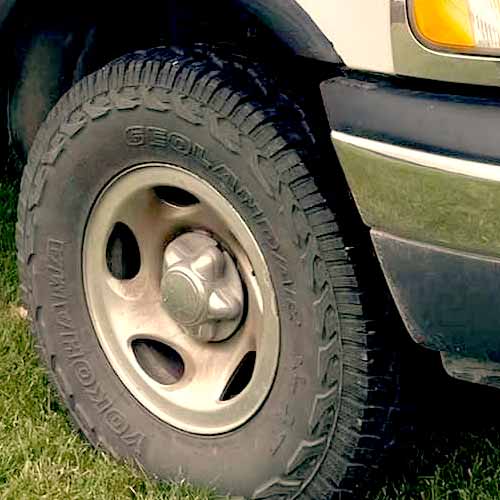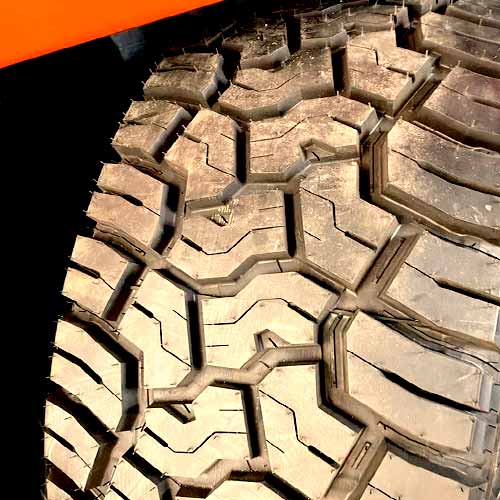Yokohama X-AT G016 is an rugged terrain tire built for 3/4 ton, 1-ton pick-up trucks. Such tires are more aggressive than all-terrain but less than mud-terrain, and performance wise it’s the same scenario. Let’s see what more this tire has to offer!

Being a tire engineer, in my opinion, the Yokohama Geolandar X-AT is a good overall pick for off road use, but the tire could use some sideways traction. It’s shoulder blocks are not optimized for rugged off road use. In other words, its confusing as the tire is clearly an RT (hybrid), but it’s sidewall lugs make an all terrain like pattern. Nonetheless, the tire does great on dry roads providing superior stability, and a very comfortable ride.
Table of Contents
Tire’s Info
Yokohama Geolandar X-AT G016 ranges 15 to 22 inches (rim diameter).
First off, one main thing to note about its sizes is that all of them come with the speed rating of just Q, which is below average for a rugged terrain, as mud terrain tires get to have to this rating and it’s a norm for them.
But I guess there is no compromise on the load ratings at least as you see them going from C to F. And with maximum ratings here the tire surely keeps it’s weight in check as it ranges from 40 lbs to 83 lbs.
(FYI, the lightest tire size is, while the heaviest is ).
Tread depth of all sizes range from 16 to 19/32″ where mostly the sizes are seen with 19/32″.
Also as the tire provides good tread life, Yokohama also gives all it’s sizes the tread wear warranty of 45k miles.
Tread Looks
Yokohama Geolandar X-AT, as has weak sides like I’ve already showed you above, I mean see it’s lugs by scrolling above, (they are not chunky enough to provide enough off road capabilities, some of the less aggressive AT tires have better side lugs).
But things are better in the middle, and the tire does recover a little here.

Here Yokohama’s boy gives you a straight-forward design of 2 main ribs making a L and a S shaped lugs, where the S ones are equipped with notches.
While the other doesn’t have any unique features and provides only rectilinear siping like the other rib.
All these sipes even on shoulders gets thicker and at the ends (towards shoulders).
Basically the smaller in width sipes are for wet traction, while the thicker slits are for snowy performance as you’ll see in the upcoming winter traction section.
Moving of towards the sides, here sipes are the same, narrow at one end, deep at the others, though still these deep sipes don’t allow this tire to have 3PMSFR.
Towards inner edges there is nothing going on, but on the outside, the blocks get serrated and give you a little bit of biters.
But as seen, those biters are still not so great, given it’s a Rugged-Terrain tire.
They do however have wide surrounding grasp on all sides where they feature bold stone ejectors, making it’s ribs here very efficient in self cleaning.
Compare Yokohama Geolandar X A/T with others
- Falken Wildpeak AT3w.
- Toyo Open Country R/T
- Nitto Ridge Grappler
- Yokohama Geolandar A/T G015
- Goodyear Wrangler DuraTrac
Ride Quality
Off road there were 2 main categories at first, all terrain and mud terrain, so to fill the gap in between, tire like Yokohama X AT were made, these tires comes in between those two.
And to put things simply, the balder the tire get, the more limited the comfort gets.
So Geolandar X AT although is not going to be as good as an AT but it’s still more comfortable then your average Mud tire, and that’s because the tire has single light weight cap ply that absorbs vibrations really well.
Noise
Noise depends on the tire’s rolling resistance, groove resonance and overall geometry.
With closed up shoulders, the Yokohama X AT offers very good efficacy overall.
Yokohama always cares about the ride’s comfort even with it’s extreme tires, that’s why it’s little brother, the Yokohama Geolandar G015 (review), is the most comfortable out there, in AT category.
The tire with closed up lugs on sides don’t allow sound to become acoustic, as most of it enters through there, the rolling sound is minimized by central rib placement.
And the little left over sound is dealt with pitch sequencing, where Geolandar X AT offer slight differences in blocks, in terms of angles, width, symmetry, on a micro level.
And all these generate different tones when air hits them, by the way, this is commonly known as tread noise.
Highway Performance
Hybrid tires are infamous for their weaker overall capabilities on streets, though it’s understandable, given their off road performance.
But how does Yokohama performs here?
Well we can find that by analyzing it’s on road factors which include the tire’s communication level, and traction.
Steering Response
When it comes to R/T tires, you have to understand that their steering response is a little limited, but overall its still okay compared to other hybrid options.
This is because the communication depends on the tire’s construction a lot, especially the cap plies, and Yokohama X-AT only has a single layer of nylon over there.
So this does two things, one it allows better mobility of tread blocks above so they provide the traction.
And second, the tire sides become less prone to understeer (or in easier words, lighter tire is easier to move).
Dry Road Traction
On dry highways, grip is dependent on how much middle area of the tire meets with the surface.
Here central area is involved as its offers the most exposure, when tire is directional.
Now in case of Yokohama X-AT, although the tire has a lot of gaps in between it’s ribs, the blocks are very fat and have very less feature on them, so not a lot of rubber area (that meets the surface) is compromised.
So overall the tire offers decent braking distance values.
Dry Handling
Dry highway handling is tricky for RT tires, as they are not designed to roll at higher speeds, and this especially goes for Yokohama’s tire here as it’s offers only up to Q in speed rating, which is below average for this tire.
But still lighter weight of the tire combined with bulky shoulder lugs, the tire is still not too far off here.
Snow Performance
Yokohama Geolandar AT-X is not 3 peak mountain snowflake rated, but that does not mean it can’t perform on snow.
Sure with those minimal sipes the on road snow grip becomes limited, and yes you can not expect any traction on ice as well, but the tire is capable of providing grip on deeper terrains, where it’s notches everywhere in the middle and deep slits on it’s shoulder trap in the snow particles and this makes
make snow to snow contact (which provides better friction, and hence traction).
Wet Performance
Wet performance is sub-categorized in to grip and hydroplaning, and although there are other factors as well, these play a more significant part in determining the overall wet abilities of the tire.
Let’s see what both areas have to offer.
Wet Traction
Wet traction is a challenge for hybrid tires, as they are more voided compared to all terrains, so grip is compromised.
But the plus point for these tires is that they are still made soft.
The Yokohama Geolandar AT-X although has a good rubber which soaks up water nicely, it’s less sipes overall causes this tire to slip on corners.
Moreover, the tire also does not offer a locking technology in it’s sipes, so they become rigid on corners, which further limits the wet grip.
Hydroplaning
Hydroplaning is avoided by clearing off water, so the faster the water gets cleared off, the more resistance to aquaplaning the tire has.
In case of Yokohama Geolandar AT-X, the deep and wide interlinked grooves are enough for clear evacuation of water.
So it’s not a problem here.
Durability
Yokohama Geolandar X-AT being a rugged tire, has a very average construction of 3 ply polyester (body plies casing), which have 2 running broad belts on top (made of high strength steel).
And a full width broad nylon cap (covering the whole middle area from underneath).
The single cap ply although compromises on structural integrity a little bit its still okay as the tire has thick rubber top here, I’d worry more for the sidewalls.
The sidewalls of the tire needs the most protection and they are 3 ply (which is the max protection that you can get), however, it’s sides are somewhat still susceptible to punctures, compared to other R/Ts, and even some A/Ts, as those tires also offer thicker lugs there which further protects the sides form close encounters.
For Your Info: In RT category the strongest tire is the Mickey Thompson Baja Boss AT, review it here: https://tiredriver.com/mickey-thompson-baja-boss-at-review/
Tread Wear
Tire’s weight (which has to do with the inner make up) and tire’s upper tread determines the overall mileage of a tire.
And overall, Yokohama Geolandar X-AT provides a good deal here.
Despite being a rugged terrain the tire offers 45k miles warranty, as the tire produces very lower rolling resistance values.
This is because with just a single cap ply the tire only goes up to 83 lbs in weight and it’s tread depth of 19/32″ is deep enough which takes time to wear off.
Off Road Traction
Off road, things get through but R/Ts can handle it. These tires can go on all sorts of rough tracks and can take on a bit of deep mud as well.
Let’s discuss all these challenging terrains.
Rock Traction
My only compliant with Yokohama X AT is it’s lateral traction component, in both wet and dry conditions. The tire does for comfort and on road traction reasons, compromises here a little bit.
It also does not offer thick enough lugs on sides, so you can’t use them by lowering the pressure down.
Don’t get me wrong they are still okay, but compared to other hybrid tires, they lack here.
In hybrid tires, one of the best RT for rocks is Nitto Ridge Grappler, review it here: https://tiredriver.com/nitto-ridge-grappler-review/
Sand Traction
Sand is a pretty tough and need some skills to move on.
But Yokohama X AT is one of the best ones here. IT offers ample footprint which is highly needed and you can go very low in air pressure with these tires as they offer very powerful rim locks which keep the bead in place.
Low pressure is very crucial on sand, and you can’t run there without, unless you have balloon tires.
Muddy Terrain Performance
Mud requires efficient self cleaning, as you can’t run a tire which gets packed with mud.
And the Geolandar X AT offers decent cleaning but only form the middle, as it’s outer lugs are not properly voided.
So mud gets a hard time going sideways, which is very crucial.
Moreover, the side lugs act as scoops and it’s our tire’s case, they don’t make good enough shoulders, as you already know by now as they affect a lot of performance areas.
Lastly, leave with this
Yokohama Geolandar X-AT although is a rugged terrain tire coming in between all & mud terrain, the tire could aggressive shoulder lugs, a little bit optimization over there can do wonders for this tire.
The good thing is the tire is very impressive on roads, and provides you with a lot of comfort.
It also handles deep snow very well but lacks a little on packed snow, with limited siping, that’s why it’s not graded with 3 peak mountain snowflake rating.